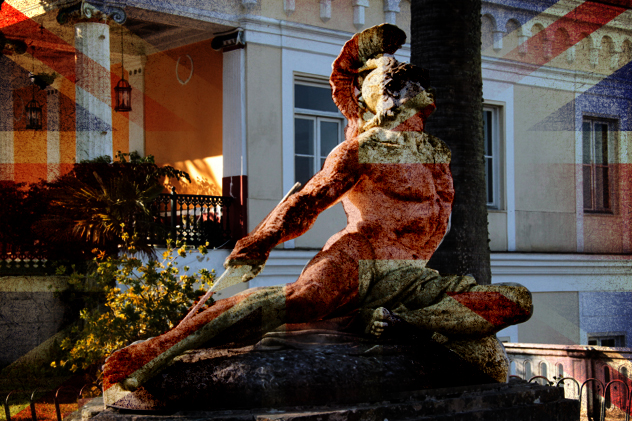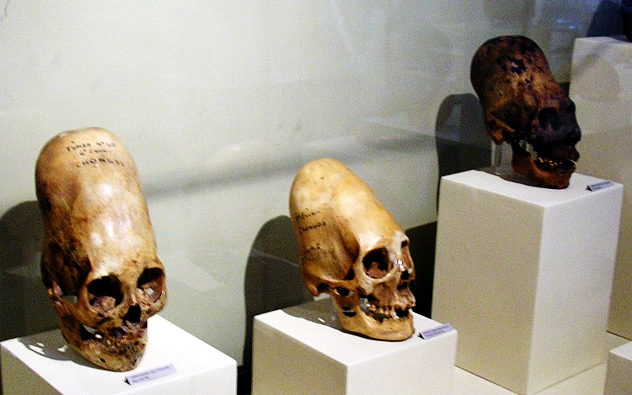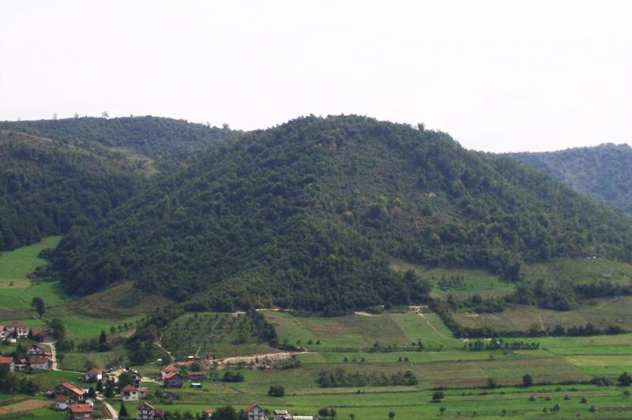 Animals
Animals  Animals
Animals  History
History 10 Most Influential Protests in Modern History
 Creepy
Creepy 10 More Representations of Death from Myth, Legend, and Folktale
 Technology
Technology 10 Scientific Breakthroughs of 2025 That’ll Change Everything
 Our World
Our World 10 Ways Icelandic Culture Makes Other Countries Look Boring
 Misconceptions
Misconceptions 10 Common Misconceptions About the Victorian Era
 Mysteries
Mysteries 10 Strange Unexplained Mysteries of 2025
 Miscellaneous
Miscellaneous 10 of History’s Most Bell-Ringing Finishing Moves
 History
History 10 Great Escapes That Ended Right Back in Captivity
 Weird Stuff
Weird Stuff 10 Fascinating Things You Might Not Know About Spiders
 Animals
Animals 10 Animals That Humiliated and Harmed Historical Leaders
 History
History 10 Most Influential Protests in Modern History
 Creepy
Creepy 10 More Representations of Death from Myth, Legend, and Folktale
Who's Behind Listverse?

Jamie Frater
Head Editor
Jamie founded Listverse due to an insatiable desire to share fascinating, obscure, and bizarre facts. He has been a guest speaker on numerous national radio and television stations and is a five time published author.
More About Us Technology
Technology 10 Scientific Breakthroughs of 2025 That’ll Change Everything
 Our World
Our World 10 Ways Icelandic Culture Makes Other Countries Look Boring
 Misconceptions
Misconceptions 10 Common Misconceptions About the Victorian Era
 Mysteries
Mysteries 10 Strange Unexplained Mysteries of 2025
 Miscellaneous
Miscellaneous 10 of History’s Most Bell-Ringing Finishing Moves
 History
History 10 Great Escapes That Ended Right Back in Captivity
 Weird Stuff
Weird Stuff 10 Fascinating Things You Might Not Know About Spiders
10 Of The Craziest Theories Proposed By Bogus Historians
We recently covered some of the strange theories of pseudohistory, and it turns out that those fringe historians aren’t alone. From the modern-day Atlantis to nuclear war on Mars, there’s some truly weird stuff out there.
10Viscount James Bryce And The Discovery Of Noah’s Ark

There are few people who are going to have more credibility than the British Viscount James Bryce. Educated at the University of Glasgow and Oxford, a professor at the latter, and one of the heads of the International Court of Justice in the Hague, he was one of the trial judges that handed down a guilty verdict to Germany after World War I.
Before all that, though, he was climbing mountains and trying to prove the absolute historical accuracy of the Bible.
In 1876, Bryce headed to Mount Ararat hoping to prove, once and for all, that not only was the story of Noah’s ark and the flood real, but that the massive ship could still be found on the slopes of the mountain. When he and his people arrived, he was assured by local authorities that no one had ever really climbed the mountain before. Some claimed to have, but it was still widely doubted how successful they’d been. Struck by the desolate wasteland and definite lack of forests on the mountain, Bryce was understandably thrilled when he came across a piece of hewn timber, about 1.2 meters (4 ft) long, lying on the side of the mountain at an elevation of around 4,000 meters (13,000 ft).
According to the book that he wrote on the discovery, his guides smiled and nodded enthusiastically when he asked if the piece, which had clearly been worked by some sort of tool, was a part of the ark. He figured that its location made sense since the ark had run aground on the top of the mountain and pieces of it would have splintered and rolled downhill.
Conveniently overlooked by Bryce, though, is the fact that the mountain had in fact been climbed on several other occasions prior to his expedition. On at least three of those cases, wooden crosses were erected at the summit. The largest of these—planted at a high elevation on the same side of the mountain as Bryce was climbing—was also said to have fallen down.
9Ulf Erlingsson And Atlantis

Mankind has been looking for the mythical remains of Atlantis for centuries, and, according to Swedish geographer Ulf Erlingsson, it’s been right in front of us all along. That’s because Atlantis is actually Ireland.
In his book Atlantis from a Geographer’s Perspective: Mapping the Fairy Land, there are a couple absolute giveaways when it comes to figuring out that Ireland is actually Atlantis—it’s so obvious, in fact, that he can’t believe he’s the first to see it. The size is about right, he claims, with Ireland measuring 480 kilometers (300 mi) from north to south and 320 kilometers (200 mi) from east to west, and it bulges a bit in the middle. There are mountains around the outside and a central plain. It’s a dead ringer for the mythical lost city.
He even knows where the myth of it sinking came from. In about 6100 B.C., a nearby shoal called Dogger Bank was hit by a massive wave and pushed under the sea, leaving people to pass down a rather jumbled story about just what body of land actually sank. He also points to the evidence that Ireland is in the middle of the geographic distribution of the megalithic sites that are found not only across Ireland, but also in England, Scotland, and the northwestern part of the continent.
But if you’re heading over to the Emerald Isle with hopes of finding remnants of the ancient civilization, you’ll be sorely disappointed. In a disclaimer about his theory, he also states that he’s not necessarily saying that Ireland and the city of Atlantis are one and the same. Plato also based everything on Ireland and its geography, but at the same time, he also said that the city wasn’t there.
8Iman Jacob Wilkens And Troy

Popularly accepted history has established the site of the Homeric city of Troy as a set of ruins sitting on the northwestern coast of Turkey. First excavated and explored in 1870, the site has an extensive history—its first defensive structures and citadels were built around 3000 B.C.
According to Dutch economist Iman Jacob Wilkens, though, that’s all absolute rubbish, because the real site of Troy is in England. He came to his conclusion after extensive study of Homer’s Iliad, and he says that a better contender for Troy than the ancient Turkish site is a place called Gog Magog Hills in Cambridgeshire. The evidence for his theory lies in the discovery of a plethora of Bronze Age weapons in the area, which seems to indicate that it was the site of a major war.
Instead of being passed down through the oral traditions of the Mediterranean, Wilkens believes that, in the second millennium B.C., the people of the English Troy migrated from Britain and the coast of Europe to settle in the Mediterranean regions. They took the story of their epic Trojan War with them, and place names got confused somewhere along the line, leading Homer to mistakenly relocate the entire thing.
7Rodney Cluff And The Kingdom Of Heaven

According to NASA, the planet’s auroras are a phenomenon created by the interaction between the magnetic fields at the poles and charged particles that have come from the Sun. According to Rodney Cluff, on the other hand, the auroras indicate the location of the opening to the center of the Earth.
The author and researcher says that he’d always been interested in the idea of a hollow Earth, and it was only after he got deep into his research on the theory that he realized the truth about what’s really beneath our feet. The retired IT specialist and Arizona Department of Health Services employee says that he’s collected an amazing amount of evidence over the years—including satellite photos and scientific recordings—that prove two things: The planet is hollow, and it’s inhabited.
Cluff says that the inside of the Earth is a paradise. In fact, it’s the Garden of Eden. He claims that it’s not only where the lost tribes of Israel have been living, but it’s also home to Viking colonies and God’s kingdom of heaven. It’s even where the flying saucers have been coming from. Some of his theories are drawn from a book called Passport to Eternity, and Cluff says that he believes the Earth will be destroyed by a solar flare in 2021. But don’t worry—the flying saucers will be ready and waiting to save those who are worthy of being saved.
He also says that he knows how to get into the hollow Earth, and directions are included in his book for anyone who’s interested.
6Gene Matlock And The Origin Of Mankind

Gene Matlock is a pretty prolific writer, touching on a myriad of historical eras and subjects. In his book What Strange Mystery Unites the Turkish Nations, India, Catholicism, and Mexico: A Concise But Detailed History of Things Divine and Earthly, he puts forth the idea that the cradle of civilization isn’t in the Middle East—it’s in Turkey.
After the great flood failed to wipe evil off the Earth, the Bible tells of the scattering of man and language after their attempt at building a tower to the sky—the Tower of Babel. Matlock says that the tower was actually built in Turkey, and when the Turks and the ancient Hindus left for the Middle East to establish the kingdom of Sumeria, they took the story with them.
He also says that the five original races of men lived in Hyperborea, a massive, all-encompassing civilization that covered what’s now Siberia; that’s also where Noah and his family lived. It was the Arctic Circle and the ancient Hyperborea that God condemned to be flooded. He then tilted the planet as the great scourge commenced and left the North Pole the frozen wasteland that it is today.
He goes on with the idea that our image of our ancient ancestors and where they came from is also wrong. He says that we are all descended from the Turks, and a careful reading of the Torah, the Quran, and the Bible will confirm that. His hypothesis is further supported by the idea that, while many other languages have evolved considerably over the generations, Turkish has remained much the same.
5Brien Foerster And The Paracas Skulls

In the 1920s, an archaeologist named Julio Tello uncovered a series of skulls while working in the Peruvian desert. The skulls were massively elongated, a trait that’s been attributed to the practice of head-binding. In Brien Foerster’s writings, he explains that he’s not arguing about the practice, but that these heads are different.
Head-binding practices change the shape of the skull, but according to Foerster, these skulls are a full two and a half times the size of a regular human skull. The only way that would be possible, he says, is if they’re genetically more than human. He also says that they’re clearly not human because of a few small holes that are present where they shouldn’t be, and the wrong number of plates making up the overall piece of bone.
According to Foerster (whose book is co-written by pseudohistorian David Hatcher Childress), there is absolutely no way the skulls can be human. He says that he obtained DNA samples from the skulls, which he sent to a geneticist for testing.
The test results—published exclusively on his Facebook page—are supposedly astounding: The genetic lab (which has gone unnamed) verified that the mitochondrial DNA is unlike anything that has ever been seen in humans or primates. While they’re presumably doing more testing, other historians and archaeologists were quick to point out that all the variations in the skulls are well within the accepted range of variance for humans.
4John Bradenburg And A Nuclear Attack On Mars

According to theoretical plasma physicist John Bradenburg, there’s a very important lesson for us to learn on Mars.
The Mare Acidalium region of Mars has an incredibly high concentration of xenon-129—a signature that’s been seen on Earth after nuclear disasters. Study of the signature has led Bradenburg to the conclusion that, at one point, Mars was home to a civilization not too far removed from ours. There was a massive nuclear explosion, though, and they were wiped out. Bradenburg is advocating a manned mission to Mars to find out just what happened to our interplanetary neighbors.
Part of his evidence for this mysterious, semi-human civilization consists of things that have long been making the rounds as pretty neat optical illusions—for example, the photo of the face on Mars. He goes on to say that he’s pretty sure it wasn’t an accident, and that the nuclear catastrophe was caused by conflict between the two Martian civilizations—the Utopians and the Cydonians. He estimates that their nuclear weapon was as powerful as one million one-megaton hydrogen bombs, and the massive explosion happened about 180 million years ago.
3Uwe Topper And His Theories On Time

A German writer, artist, and self-appointed historian, much of Uwe Topper’s prolific writings deal with the fact that time has largely been made up by past historians. Basically, he says that everyone’s lying about when everything happened.
The problem started in a couple different ways. The Christian monks who have largely been responsible for establishing time were using a complicated system of numbers based on the Bible. Years were packaged into groups based on what happened when—the year 666 is referred to as the year of the Antichrist (and, Topper incorrectly says, the year that marked the beginning of Islam), while 369 was the beginning of the Christian church. And 1260 was the year given to the end of everything. It was all figured out by adding and subtracting and maneuvering what were thought to be sacred numbers, and it got pretty confusing.
Eventually, the Catholic Church decided that they’d had enough and decided to base everything on the Anno Domini system, which revolves around the birth of Christ. Dates were recalculated with this new system, and suddenly everything got assigned to another year.
Topper also says that more problems occurred when major, worldwide catastrophes struck the planet and halted time, at least when it came to the development of the human race. These catastrophes also tipped the planet, meaning that pretty much everything we’d previously known about the timing of astrological events changed. He calls them “jolts.” These massive events resulted in a change in the length of days, years, and seasons, and have ultimately meant that our concept of modern chronology is completely wrong. We’ve just fiddled with it enough to believe it’s right.
2Joseph Smith And The Ancestry Of Native Americans

According to the origin story of the Book of Mormon, Joseph Smith discovered a set of inscribed gold plates and translated them into the Mormon religious text. Part of the teachings in the book involve a pretty strange origin story for Native American people.
In 600 B.C., one family fled from Jerusalem. Their descendants split into two groups, the Lamanites and the Nephites, and the Lamanites traveled across the ocean and settled in the Americas. Eventually, groups of these new Americans built more ships and continued on to settle the islands in the Pacific. That not only made all Native Americans Israelites, but it also established a much longer history for Mormonism than it might otherwise have.
Over the years, the whole thing has caused quite a bit of controversy, mostly stemming from the book’s pretty straightforward use of racial terms. The Lamanites were cursed with what was described as “skin of blackness,” and they’re also referred to not just as nonbelievers, but as “a dark, filthy, and loathsome people.” In chapter summaries added to the book in 1920, it was specified that, when these “loathsome” people repent, they become “white and delightsome.”
Needless to say, there’s pretty much no scientific support for the claims. According to analysis of mitochondrial DNA, modern Native Americans can conclusively trace their ancestry back to Mongolia and southern Siberia; about 98 percent of the Native Americans who were tested share DNA characteristics with people from these areas—showing that not only are they not a tribe of Israelites, but they also migrated to the Americas in the opposite direction that Smith claimed.
Recently, the LDS Church has re-worked some (but definitely not all) of its literature to be slightly more racially sensitive.
1Semir Osmanagich And The Bosnian Pyramids

A Bosnian expat living in Houston, Texas, Osmanagich has made some pretty hefty claims about what he’s found hiding in plain sight in the Bosnian landscape, and support for his theories has been overwhelming.
Already the author of several books (which include a history of the Maya and how they came to the Americas via Atlantis and the secret underground Nazi base in Antarctica, where Hitler once faced off against Arctic explorer Admiral Richard Byrd), Osmanagich’s major discovery is the largest complex of pyramids in the world—or, rather, what’s left of them.
While he was on a book tour in 2005, he noticed the incredibly exact formation of the mountain Visocica. Realizing that it was perfectly aligned with the cardinal directions, he determined that it was a pyramid. It’s now called the Bosnian Pyramid of the Moon. In spite of everyone at the National Museum of Bosnia thinking that it was a pretty good joke, he set up a nonprofit organization for the study of the pyramids . . . and was flooded with hundreds of thousands of dollars in donations and an outpouring of support from the war-ravaged country.
Geologists continue to call the results of his excavations mundane, pointing out that not only are the structures obviously not pyramids, but they’re easily explainable—the peculiarly shaped mountains are called flatirons, and they’re everywhere. Unperturbed, Osmanagich continued excavating, finding plenty of burial mounds that were suspiciously skeleton-free.
While many have embraced his theories with a new sense of pride in their pyramid complex, there’s also a very outspoken group of scholars that are taking aim at him not only for being a fraud, but for perpetuating a hoax at the expense of a country in desperate search of a national identity.








